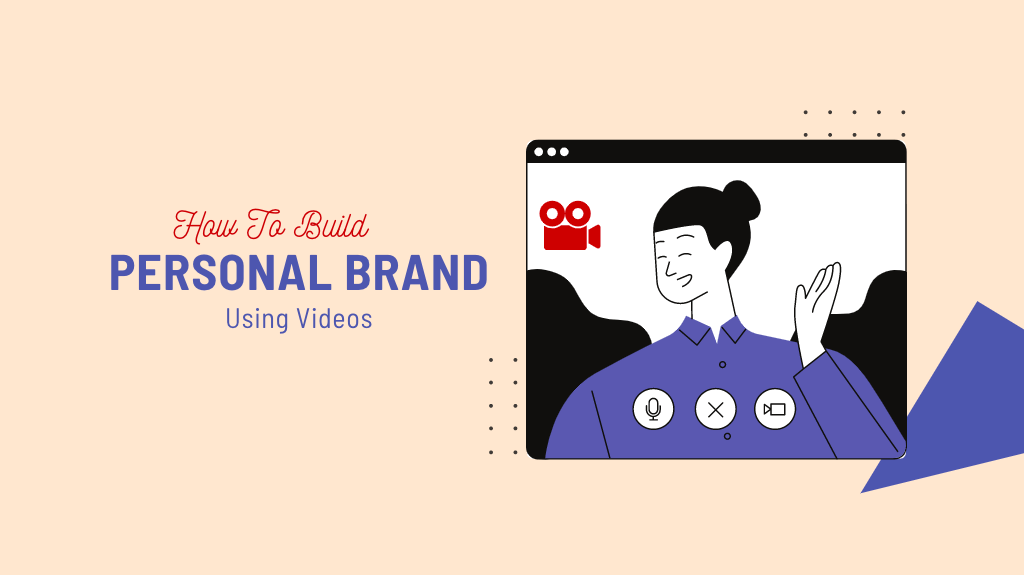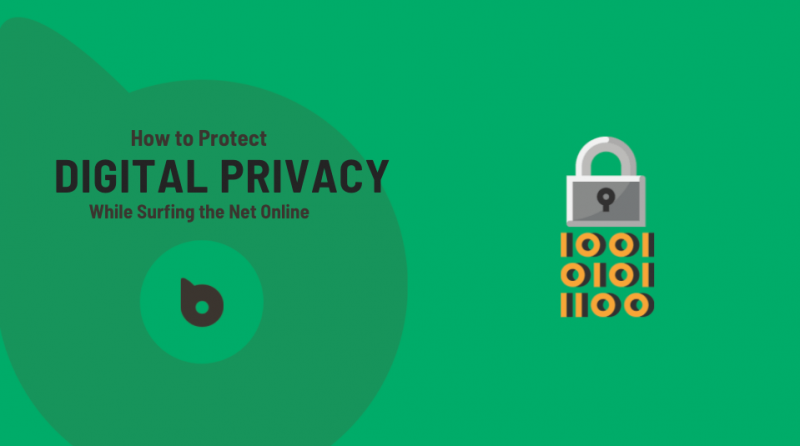I’m a content marketing professional and used to devour publications and consume a LOT of media related to the industry.
Now though, there are only a few email newsletters and YouTube channels I spend time on — even fewer that I look forward to. When looking for advice related to content marketing, I prefer finding blog posts by a handful of brands, and more specifically, by some people I like.
You see, with the huge amount of content being produced every day, personal branding is a moat against the competition. People like hearing from other people over businesses. And they will connect better with you through a richer communication medium like video.
Further, video is a convenient consumption medium. So your audience won’t mind watching multiple videos from your YouTube playlist(s) — if you create binge-worthy and valuable content — once they discover you.
But where do you start to build a personal brand? What should be the ideal frequency of publishing videos, and how can you increase your reach? Building a following on various platforms is essential. For instance, gaining followers on TikTok can significantly boost your visibility and engagement, helping you reach a broader audience.
Let’s address the overarching framework and look at a few video marketing tactics in this article.
Streamline The Mechanics
Here are a few elements you can begin with to ensure your personality shines through in your videos, and you start your brand on the right foot.
Get Comfortable on Camera
As a creator new to the video format, you might feel vulnerable while producing your first few. Video is a more authentic medium of communication, you see. So take some time getting used to watching yourself on a screen.
If it feels weird, then film a few videos as a learning experience. You may find that you hold a lot of tension in your shoulders or jaw, leading to weird body language — so relax them. Also, experiment with the space where you shoot, rehearse from a written script, and get constructive feedback from your colleagues.
Overall don’t try to portray how you want people to perceive you. Faking an “authoritative” persona by using a dense voice tenor will hurt you — people will see through it. Trying to adopt an accent to please your audience will actually turn them off.
People like watching casual, friendly, and conversational people — of course when they have something valuable to speak. Think of someone like Gary Vaynerchuck. He’s animated, swears, and oozes energy in all of his videos. His rawness appeals to his audience. He has even created a film explaining why he curses!

It might take you some time to find your voice and personality, but let them take shape organically. Don’t force yourself into something that you’ll regret later.
Establish Your Workflow
Once you start trusting yourself in front of the camera, find out what works for you. I’m collaborative in my video projects. So I focus on the performance and script for my videos but prefer external help from a camera person and a video editor for pruning the final cut.
I like to film my videos with a video production lead. Another person’s presence provides real-time feedback on what I can execute better from my script or the parts I can eliminate.
If the cost of hiring such a professional goes outside your budget, consider hiring video production interns with some relevant experience.
It isn’t a bad idea to buy a tripod stand for your Smartphone from Amazon, indulge in video editing yourself, and take care of the complete process yourself. It gives you creative control over the end product, though it could take you some time to learn video editing.
Once you’ve sorted out how you’ll film and produce your videos, move on to the next step.
Get Your Branding Elements Right
Do you have an existing color palette for your brand? If no, then settle on a combination that you’ll use in your thumbnails, your website, and other touchpoints of your brand — even the in-video setting, if possible.
Other elements you can begin with are your logos, maybe a personal brand statement, your brand values, positioning, and the like. You can learn more about brand identity here.
Debut on YouTube
YouTube channels are the internet’s default way for video projects. Whatever kind of audience you want to reach, launching yourself on this platform is a no brainer.
When creating a YouTube channel, plug some information about yourself in the about section and design a cover image using Canva. Also create a template for your video’s thumbnails, including the style of the text, font combinations, and colors you’ll use.
Lewis Howes, for instance, uses orange and black colors along with the featured person’s picture in his thumbnails. This trademarked style makes his videos recognizable on YouTube.

Launch Your Website And Email List
While hosting videos on YouTube is great for a start, launch your website as soon as you can. It’s the only place where you have complete control of a visitor’s experience and can establish your credibility instantly. You can build your website without learning how to design or code — so put it on your to do list.
Delaying building your website is fine, but definitely launch an email list alongside your YouTube channel. Mailchimp offers a free plan for up to 2000 email subscribers, which is perfect.
Sign up and nurture your video brand’s community from the get-go. Remember your email subscribers will be much more loyal and valuable for you over your YouTube subscribers.
Contemplate Branding Beyond YouTube
There are two possible scenarios when you can ditch YouTube or at least treat it as your secondary video marketing channel.
1. Expanding your brand through teaching – Mike Omar is an internet marketer who created over eleven hours of exhaustive videos on making money online — and offered them for free.
But he didn’t put the content on YouTube.
He packaged the videos into an online course on Udemy.
And do you know how many students have enrolled in it over the years?
Over 200k!
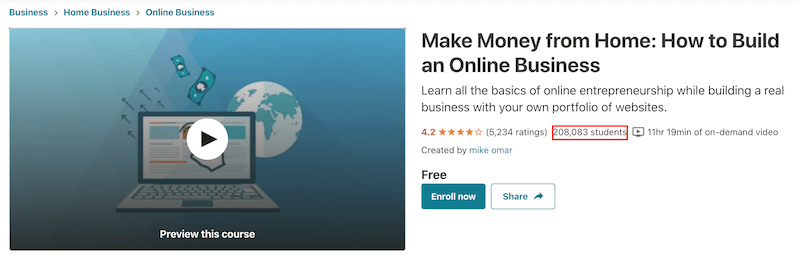
And those are students who are proactively signing up and engaging with his course — watching lectures, asking questions, sending him emails, and the like.
Launching your brand by teaching exclusively on online course platforms such as Udemy and Skillshare is an underused branding strategy. The threshold for quality of production on such platforms is considerable, but the competition hence is lower.
I would call free Udemy and Skillshare courses a bargain to reach people hungry to learn and binge-watch educational content. Indeed Shani Raja, an ex-Wall Street Journal editor, transitioned in his career to become a full-time writing coach through his courses on Udemy.
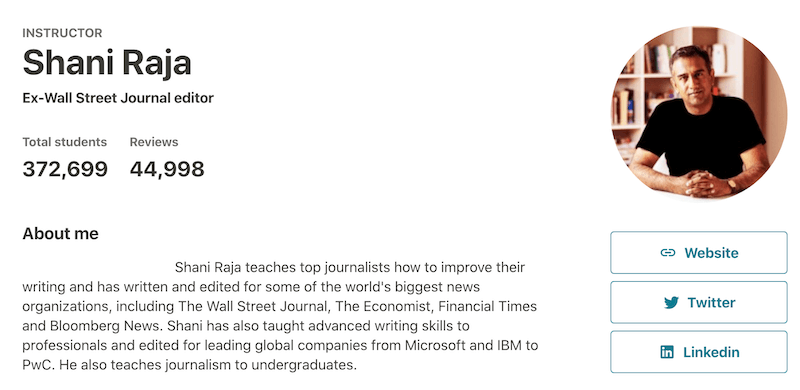
2. Get granular control over the viewing experience of your videos – If you have an existing raving following, then the ads, autoplaying videos, and overall design of YouTube might not be the ideal experience for them.
It might make more sense for you to buy a package from video software companies such as Wistia. And host people on your website, thereby providing a personalized branded experience.
Brad Smith, the founder of content production agency Codeless, hosts his weekly show on his Wistia channel. But he exclusively releases them on his website — which allows him to add transcripts, table of contents, email capture forms, and customize the experience of his videos.
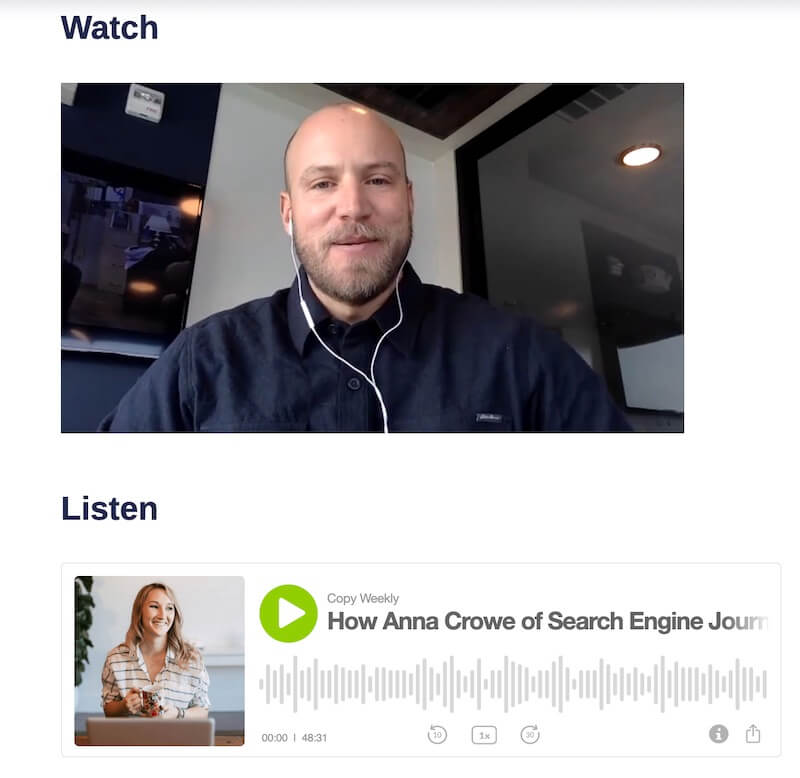
Both of the above scenarios also go well with conducting free webinars around your audience’s pain points. Indeed you can generate leads for your business and grow your brand on autopilot by choosing a webinar software that lets you run automated pre-recorded webinars.
The guys at Authority Hacker use such automated training on building profitable websites (important for their audience) to lure their website visitors into their funnel.
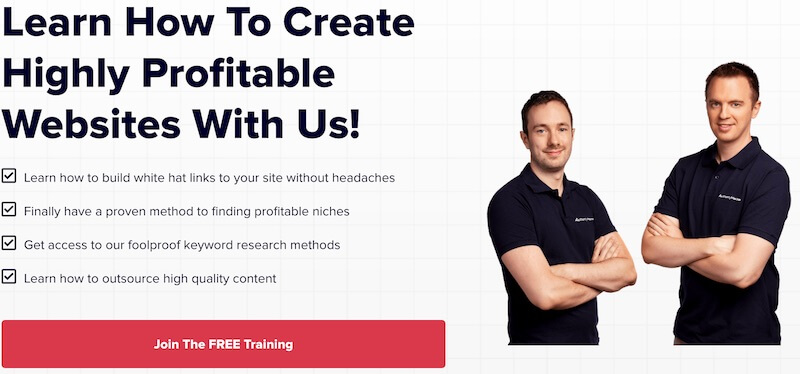
Pick A Niche, But Don’t Mind Pivoting Along The Way
The global share of internet traffic of videos keeps climbing every year. So you would think that consumers are saturated with them and spoiled for choices.
Not so much.
Well — if you take into account the “niches” that exist.
Becoming just another lifestyle vlogger or internet marketing guru might involve high competition. But what if you create a weekly show teaching software to marketers? It will probably earn more interest and get a loyal following that watches your videos enthusiastically.
So defining how you’re unique and demonstrating your expertise in a subject matter (with decent demand) is important. Of course, you need to enjoy teaching and creating videos about it. Finding such niche interests is similar to the initial steps when starting a blog, involving these steps:
- Make a list of your top five passions that you’ll enjoy teaching and speaking about.
- Find the existing channels and personalities creating videos on these subjects. Explore the kind of videos they are making, the products they are selling, their viewership, and how you can differentiate yourself from them.
- Take help from Google Trends, but YouTube tools such as TubeBuddy are more useful in finding the search volume for specific search terms in your niche.
For example, when I plugged in “content creator for SaaS”, the tool returned a poor volume score for the keyword. However, it got a good overall rating. I also like its “most used tags” section — it provides me with many related subjects to go after.
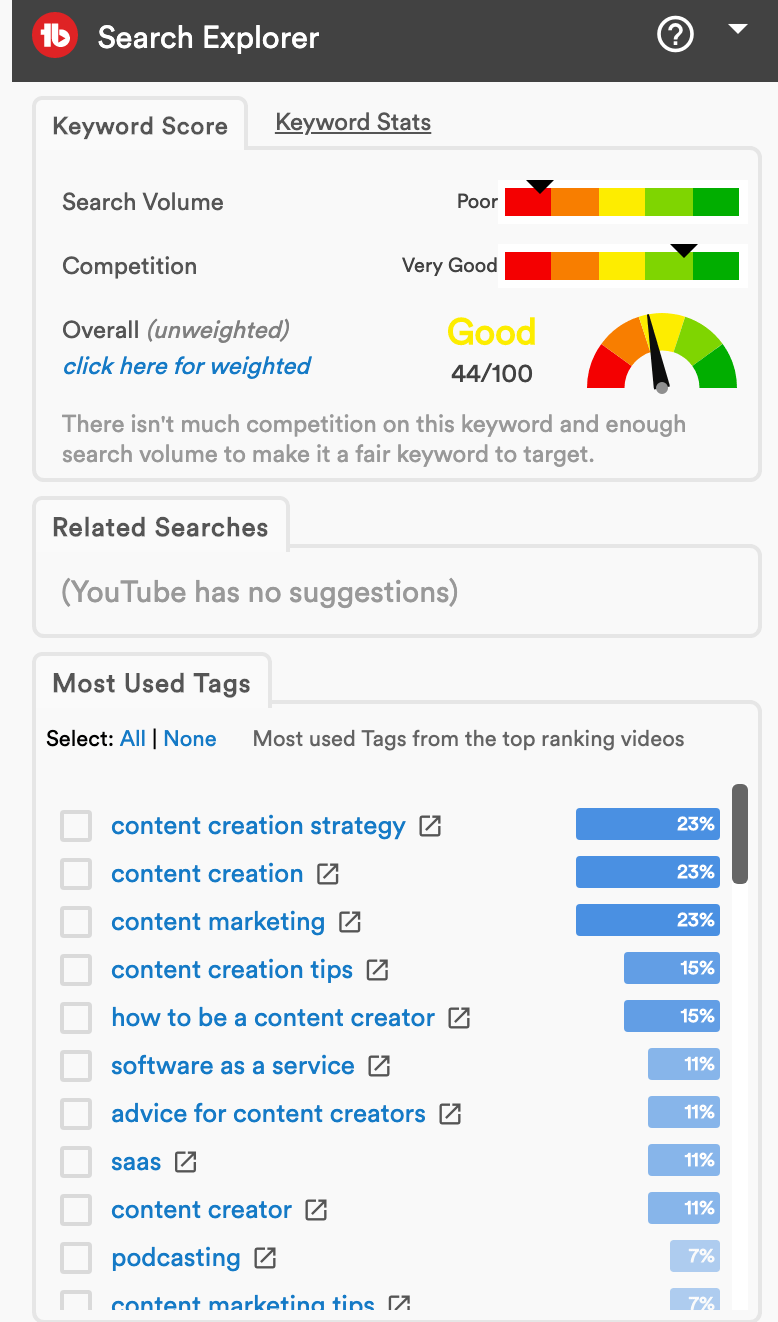
Often you’ll start with a specific niche but find it doesn’t fit quite right. You can always experiment with different subjects to see which ones you enjoy more and where people are responding better.
Cathrin Manning started her YouTube channel by creating videos about blogging and how to use Pinterest for driving traffic to your website. But she kept experimenting with other subjects.
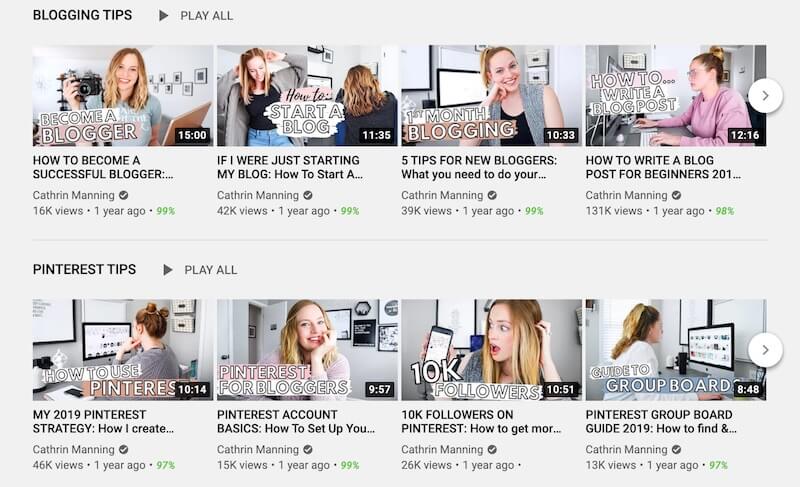
She found soon that her YouTube subscribers preferred her videos sharing her YouTube journey. Now she has pivoted to creating vlog style videos for new YouTubers — breaking down how to grow on YouTube, editing tips, guidance on money-making, and the like.
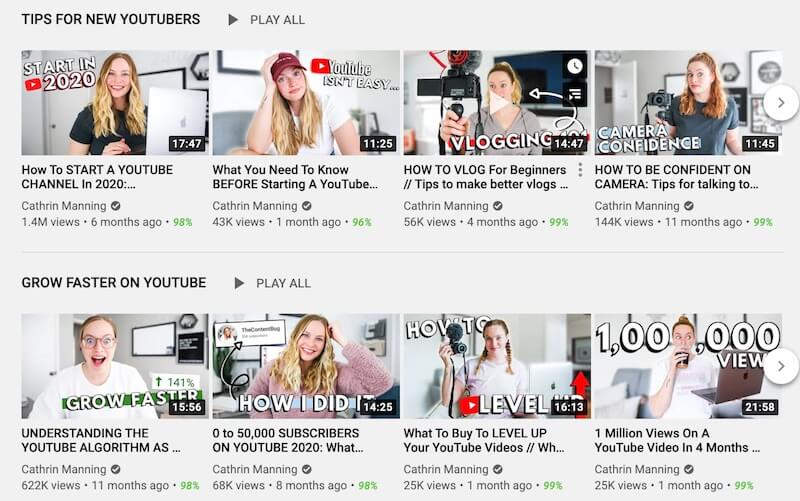
Once you find your niche, stick to it. Occasionally it’s okay to target a wider audience, though you will need to get creative with your videos. For example, vidIQ is a YouTube growth, marketing, and SEO tool. They share tips, resources, and examples of everything related to YouTube on their channel.
Occasionally, Rob (the channel’s host) experiments with subjects thinly related to YouTube growth. For example, four of their top five videos (as evident in the screenshot below) talk about Mr. Beast, T Series, downloading a YouTube video, and so on. The idea behind these is to appeal to a wider audience base.
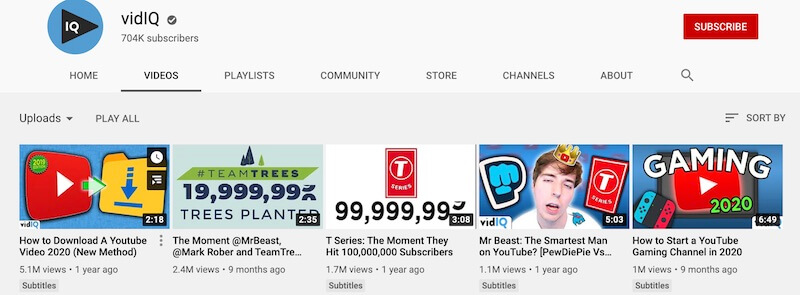
Research Relevant Subjects And Publish At A Regular Cadence
Want the formula to get people excited about hearing from you?
Share high-quality content that helps your audience and publish it at a consistent frequency to create anticipation.
But how do you find the topics you’ll cover in your videos?
They can be sourced from the three buckets below, but feel free to experiment with other kinds of content as well.
1. Pain points of your audience – Try to talk to your audience and get them to share their concerns, problems, and interests in their own words. If that’s not possible, explore frequently asked questions on Quora on your subject matter expertise, niche forums, and the like.
Suppose you want to build a personal brand around parenting. Just plug the topic in Quora to get the top questions on the subject:
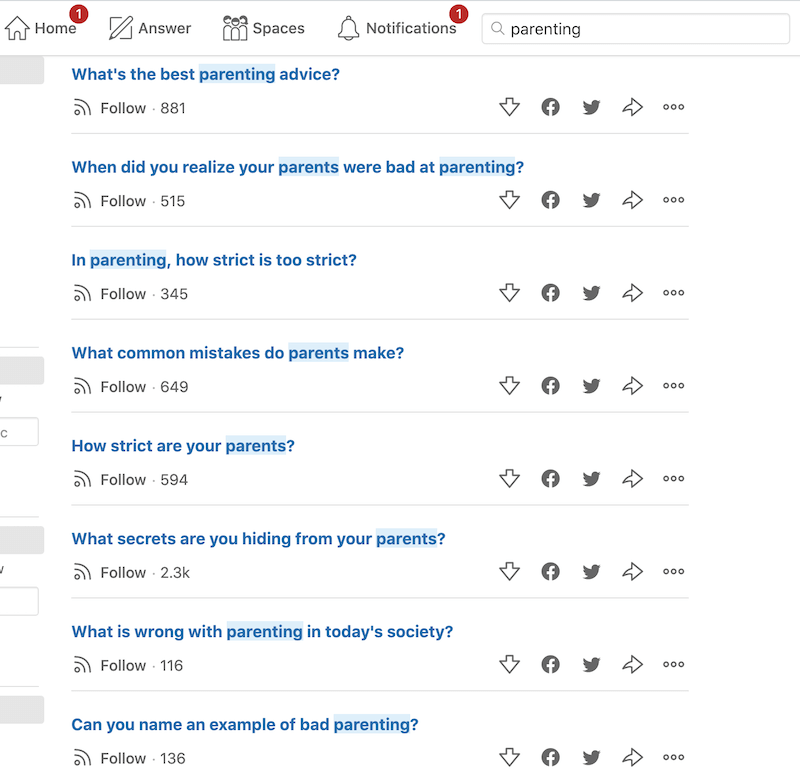
2. Competitor research – Look at what your competing YouTube channels and influencers in your niche are producing videos about.
Suppose you’re a Pinterest marketer and want to build a brand around it. A couple of YouTube searches on Pinterest marketing will reveal channels such as this one by Anastasia Blogger. From there, hover to their popular uploads to get an idea of what kind of videos you can create.

Try to find the videos that are currently trending in your industry — over their lifetime popularity as apparent through aggregate YouTube views — by using vidIQ.
With this tool installed, you get a “trending” tab for every channel you visit, though it needs a certain amount of viewership to work. From here, you’ll find the videos with the highest views per hour right now. Here are the results for Anastasia’s channel:
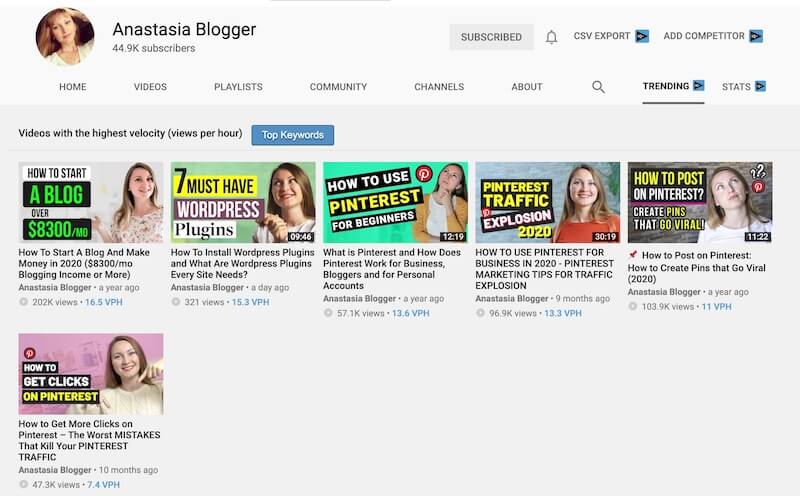
Compare them with the “popular uploads” we saw in the last screenshot to find the ideas which would be relevant right now.
3. Keyword research – This is a classic market research strategy that you might’ve used for textual content creation. You can find low-competition keywords with decent popularity that your channel’s videos could be optimized and later rank for through TubeBuddy.
Suppose you’re a guy who wants to create your brand around hairstyling. A relevant keyword for your channel could be “hairstyling for men”, which is an overall great catch as per TubeBuddy.
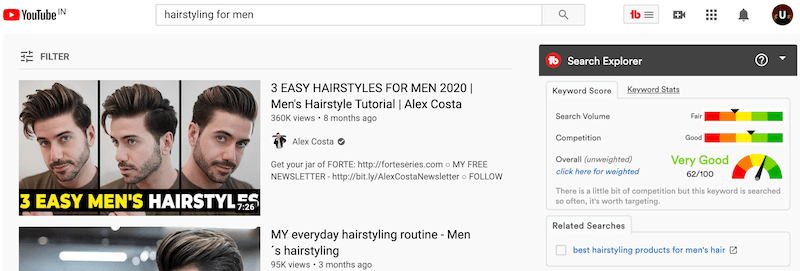
You can also create videos based on your personal experience on the subject. For example, If I were to appeal to an audience looking for “vegetarian food recipes”, I could create a video about what most chefs get wrong with vegetarian food.
I could also make one around “lesser known vegetarian ingredients” to bring flavor to your food.
Such “original” subjects over research-based ones differentiate you from other creators and build your thought leadership.
The next step is picking a publishing frequency that doesn’t lead you to compromise on quality — daily, weekly, fortnightly, or anything else.
Kevin Indig, VP SEO & Content @ G2, who has built a formidable reputation of B2B folks, is publishing at a cadence of over one video per week right now. He’s mixing it up between long interviews and short informational videos — which you can also experiment with.
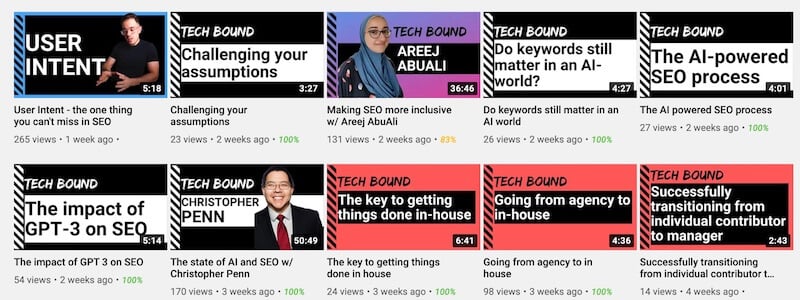
Once finalized, document your strategy, including the topics you plan to cover, and attach deadlines to them in a content calendar. Something as simple as an excel sheet will work for this. But I like to top it up with a visual project manager such as Trello.
After you’ve panned out the stages from the ideation of a video to its production, create a Trello board for it. Here’s an example of a textual content calendar:

Here’s the Trello content calendar template you can copy and personalize based on your workflow. Once dates are down in the calendar, your job is ensuring you stick to the publishing deadlines.
Set Up Distribution
Let’s face it:
The competition on YouTube is fierce.
Unless you have existing traffic on your website or an existing personal network, you’ll find it difficult to get viewership on your videos.
For complete beginners without an existing audience, I recommend starting with the distribution strategies below. None of them might be able to help you beyond a few hundred views, but that’s decent to get started.
1. Guest Posts – Getting published as a guest author will expose you to newer audiences. So if you’ve decent writing skills, then pitch articles related to the videos you create to authoritative websites in your niche.
You can begin with a Google search “your niche” + guest post to find such opportunities. But read these guest posting tips for further help.
Most websites will appreciate a multimedia experience and will happily let you embed your relevant YouTube videos in guest posts. For instance, here is the FAQ section for the contributor program at e27, a startup and technology publication. Notice how video articles get a concession on the word limit!
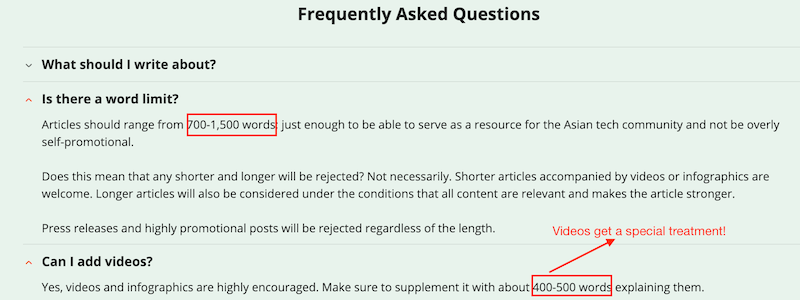
2. Pinterest Marketing – Pinterest is a visual search engine besides being a social media platform — and the shelf life of posts on it is much longer than Facebook and Twitter.
Are you in a visually appealing niche related to food, travel, fashion, or photography? Great — Pinterest could be a goldmine to drive clicks to your channel.
Even finance, marketing, blogging, and a few nerdy topics gather some attention on the platform. But research if Pinterest influencers with a monthly viewership of about 100k exist. If they do, then it makes sense to experiment with a Pinterest business profile to promote your YouTube channel.
Shreya Dalela took her brand’s Pinterest profile to over 1.5M monthly viewers within a few months. She recommends scheduling 20-25 pins throughout the day consistently for about 60 days using a tool such as Tailwind. These high-quality pins should be related to your niche, but majorly create pins with links to your channel’s videos.
Here is a detailed article about the best Pinterest pin scheduling tools with a few more tools.
The above process could be your ticket to touching a monthly viewership of 100k on Pinterest, which will then serve as a launchpad for your YouTube videos as well.
Watch Cathrin Manning detail a similar Pinterest strategy for YouTube video promotion she followed below:
3. Community Marketing – Do the above strategies sound like too much effort? This last one is the least effort of all. Find forums and communities in your industry where conversations related to your videos are happening. They would probably be questions on Quora, subreddits, or Facebook Groups — but niche forums also exist for many industries.
Once you identify a few great communities, read their rules, and abide by them. Here are the rules for the Authority Hacker Facebook Group.
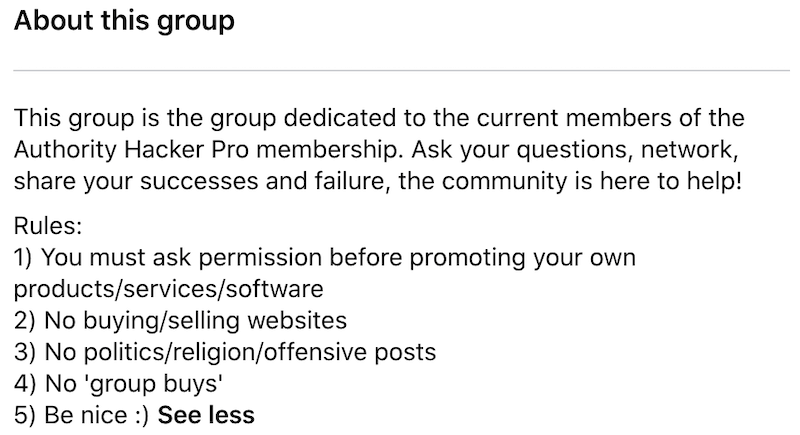
They clearly state asking for permission before promoting your products and services. I would err on the side of caution and ask them before promoting my videos as well.
You can’t share personal links straightway, anyway. First, add value to the group by answering questions asked by the members and participating in discussions. Then depending on the self-promotional etiquette of the community, share your YouTube videos occasionally.
But don’t behave like a desperate marketer and simply drop links. You’ll get called out even when you post great content such as this one:
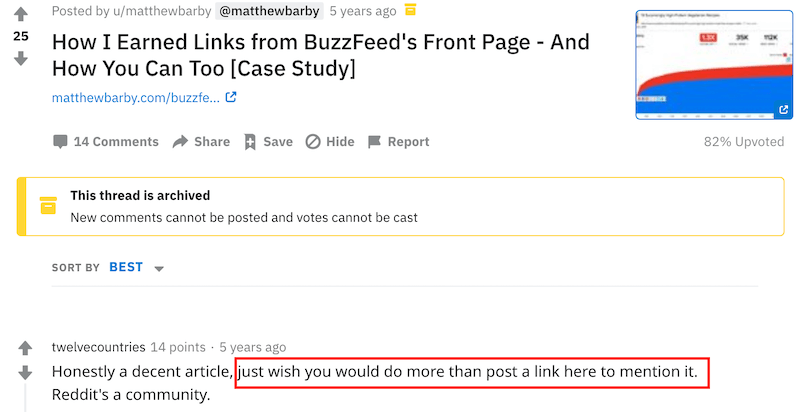
Give some background information about the video, why it adds value to the community, and invite people to engage with you in comments. Here’s how Matthew Barby, the above Reddit user, provided extra info about their link.
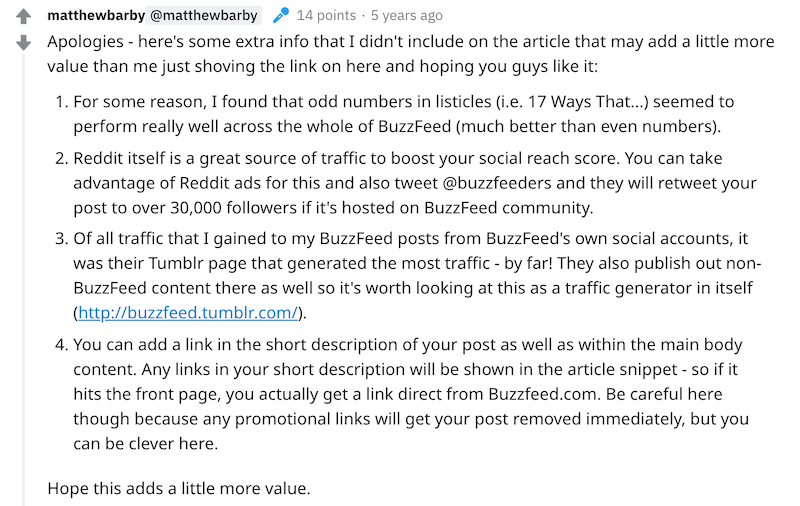
Making genuine efforts to connect with a passionate community in your niche, coupled with high-quality video content, could be your ticket to an engaged following. You can explore driving traffic from forums in detail here.
If all of the above distribution tactics sound like much more effort than you probably want to put in, then I won’t blame you. But promotion would initially be more important than producing your videos — else your channel will continue lying in the dark corners of YouTube with merely your friends and family gracing it.
Analyze Your Performance
Do you dream of going viral with a funny video?
While I appreciate your enthusiasm, building a personal brand doesn’t need that.
Especially when you’re niching down to a narrow audience of B2B folks, even a few thousand views is equivalent to decent performance. Look at the total viewership of the popular uploads on the SaaS Marketing Vlog channel by Ahrefs, a SaaS company.

Views, subscribers, and the reach of your content for measuring your personal branding efforts aren’t ideal anyway, as these are vanity metrics. It’s better to gauge the engagement your videos receive and monitor their watch time — YouTube analytics gives access to both.
The payoff from personal brands generally comes in the form of new professional opportunities, so they are good indicators of success. It could include consultation inquiries and job offers — if you’re teaching a skill useful to businesses. But you can also get channel collaboration requests, sponsorship proposals from brands, and the like.
Once people are watching you and sharing positive feedback, it’s up to you how you want to monetize your personal brand. A straightforward way is to launch a private paid community and serve them exclusive content, like Indig.
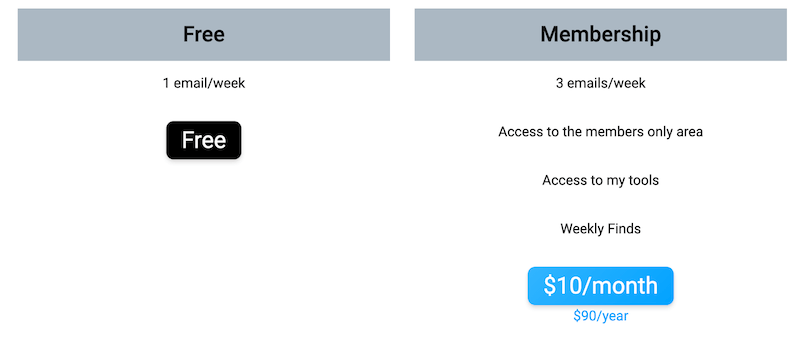
But promoting products as an affiliate, creating online courses, building a speaking career, launching a digital product, or setting up a new company — all options will be the cards!
Final Thoughts
Whether you like it or not, people research you online. If they find something they like, they remember you, maybe consume more of your content, and possibly buy from you when they need help. So get started with taking control of what people see when they Google you!
Video is an authentic content format to kick off your personal brand. It can help you build genuine relationships with people and invite lucrative professional opportunities in your career.
Hope this guide provides clarity and direction on how you can get started with building your personal brand.
Have you ever experimented with producing videos, and people reacted positively to them? Let me know in the comments below.

